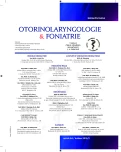Labio-Glossopexy in a Patient with Pierre Robin Sequence
Authors:
J. Hybášková 1; T. Vítečková 2; R. Poláčková 2; Karol Zeleník 1,3
; Pavel Komínek 1,3
Authors‘ workplace:
Klinika otorinolaryngologie a chirurgie hlavy a krku, Fakultní nemocnice Ostrava, přednosta prof. MUDr. P. Komínek, Ph. D., MBA
1; Neonatologické oddělení, Fakultní nemocnice Ostrava, přednosta MUDr. R. Poláčková
2; Katedra kraniofaciálních oborů, Lékařská fakulta, Ostravská univerzita, vedoucí katedry prof. MUDr. P. Komínek, Ph. D., MBA
3
Published in:
Otorinolaryngol Foniatr, 64, 2015, No. 2, pp. 119-121.
Category:
Case Reports
Overview
Pierre Robin sequence is a congenital malformation. One of its typical sign is micrognathia, which often causes retroposition of the tongue with possible significant airway obstruction and feeding difficulties. If conservative treatment is not sufficient, a surgical procedure can be performed. Labio-glossopexy in patients with PRS should be balanced against the other operations, namely tracheostomy and mandibular distraction. Labio-glossopexy is less invasive method then tracheostomy, simplifies nursing care, shortens hospital stay and makes homecare less demanding.
Keywords:
labio-glossopexy, tongue-lip adhesion, Pierre Robin Sequence, airway obstruction
Sources
1. Argamasso, R. V.: Glossopexy for upper airway obstruction in Robin Sequence. Cleft Palate – Craniofacial Journal, 29, 1992, s. 232-238.
2. Bijnen, C. L., Don, G., Mulder, W. J., Haumann,T. J., Van Hagen, A. J.: Tongue-lip adhesion in the treatment of Pierre Robin Sequence. The Journal of Craniofacial Surgery, 20, 2009, s. 315-320.
3. Souhlas, B.: The treatment of micrognathia associated with obstruction by a plastic procedure. Plast. Reconstr. Surgery, 1, 1946, s. 300-308.
4. Dykes, E. H., Raine, P. A. M., Artur, D. S.: Pierre Robin Sequence and pulmonary hypertension. Pediatric. Surgery, 20, 1985, s. 49-52.
5. Fayoux, P., Hosana, G., Bonne, N. X., Nicollas, R.: Tongue – lip adhesion. European Annals of Otorhinolaryngology, Head and Neck Diseases, 130, 2013, s. 99-102.
6. Hoffman, S., Kahn, S., Seichik, N.: Late complications in the management of Pierre Robin syndrome. Plast. Reconstr. Surgery, 35, 1963, s. 504-511.
7. Kirschner, R. E., Low, W. L., Randálů, P., Bartlett, S. P., McDonald-McGinn, M. D., Schultz, J. P., Zackai, E. H., LaRossa, D.: Surgical airway management in Pierre Robin Sequence: Is There role for tongue-lip adhesion?. Cleft Palate – Craniofacial Journal, 40, 2003, s. 13-18.
8. Meyer, A. D., Lidsky, M. E., Samson, D. E.: Airway intervention in children with Pierre Robin Sequence. Otolaryngol. Head Neck Surgery, 2008, s. 782-787.
9. Robin, P.: Glossoptosis due to atresia and hypotrophy of the mandible. Am. J. Dis. Child, 48, s. 541-547.
10. Scharff, A. S., Darrow, D. H.: Labioglossopexy and epiglotopexy. Operative Techniques in Otolaryngology, 16, 2005, s. 203-208,
11. Scott, A. R., Tibesar, R. J., Sidman, J. D.: Pierre Robin Sequence, evaluation, management, indication for surgery and pitfalls. Otolaryngol. Clin., 2012, s. 695-710.
12. St-Hilaire, H., Buchbinder, D.: Maxillofacial patology and management of Pierre Robin Sequence. Otolaryngologic Clinic of North America, 33, 2000, s. 1124-1256.
Labels
Audiology Paediatric ENT ENT (Otorhinolaryngology)Article was published in
Otorhinolaryngology and Phoniatrics

2015 Issue 2
Most read in this issue
- Augmentation of Vocal Cords by Autologous Fat
- Present Diagnostics and Therapy of Inflammations of Maxillary Sinuses in the Czech Republic – Evaluation of a Questionnaire Survey
- Juvenile Recurrent Parotitis and Selective IgA Deficiency
- Massive Cervical Hematoma Developed Due to Spontaneous Rupture of External Carotid Artery
